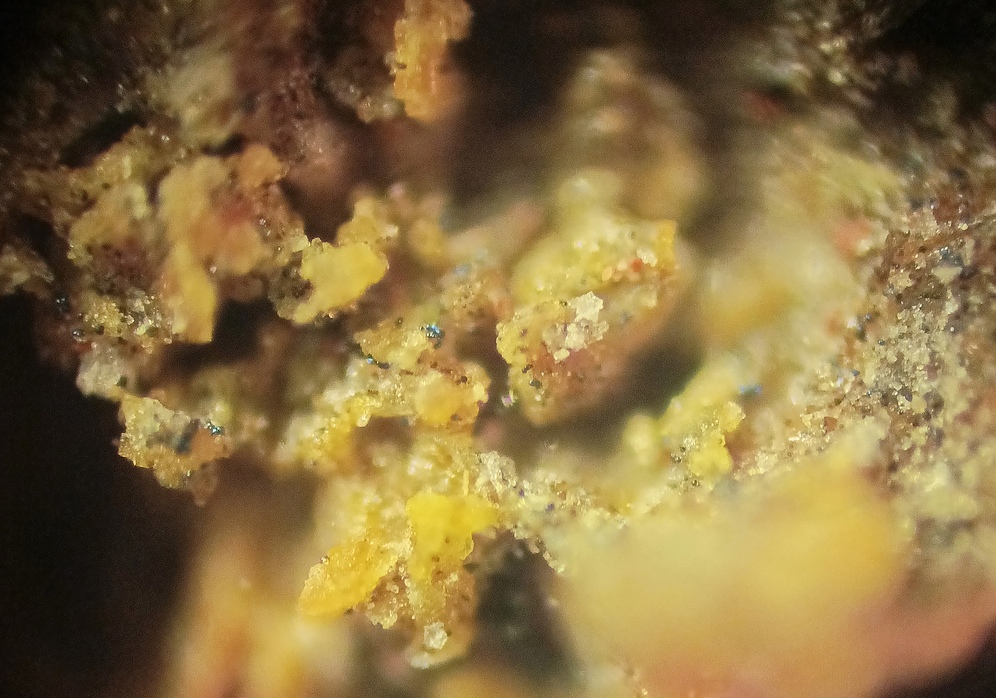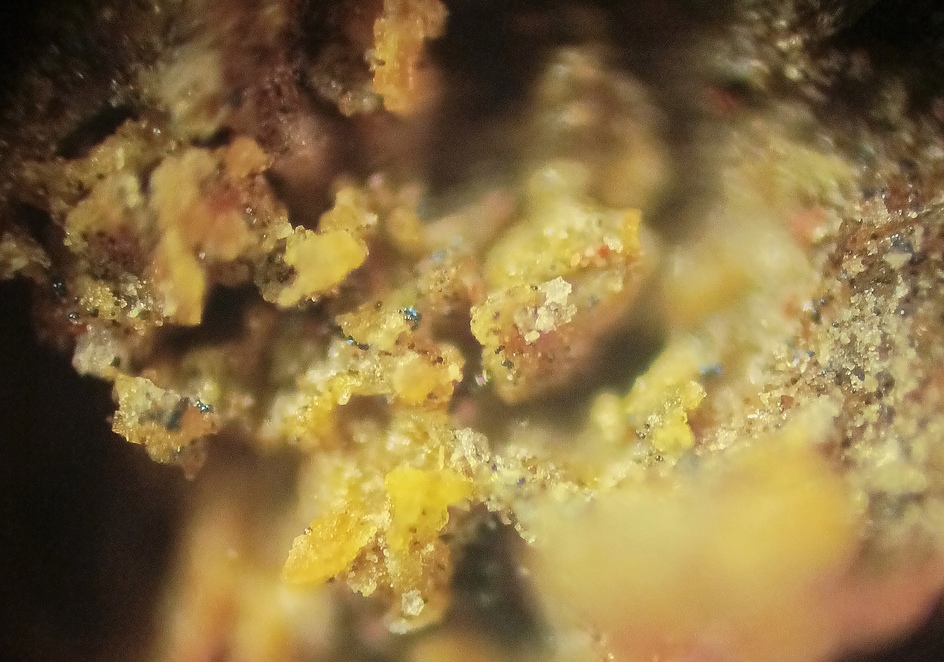Pliniusite
A valid IMA mineral species
This page is currently not sponsored. Click here to sponsor this page.
About Pliniusite
Formula:
Ca5(VO4)3F
Colour:
Colorless or white
Lustre:
Vitreous
Specific Gravity:
3.402 (Calculated)
Crystal System:
Hexagonal
Member of:
Name:
Named in honor of Gaius Plinius Secundus (AD 23/24 – 79), called Pliny the Elder. He was a Roman author and naturalist, and a naval and army commander. He wrote Naturalis Historia ("Natural History"), which became a model for encyclopedias.
Pekov et al. (2022) report the discovery of a new apatite-group mineral, pliniusite, ideally Ca5(VO4)3F, the second vanadate mineral of the apatite supergroup, in fumarole exhalations at the Tolbachik volcano (Kamchatka, Russia) and in a pyrometamorphic rock of the Hatrurim Complex (Israel).
Pliniusite, fluorapatite Ca5(PO4)3F, and svabite Ca5(AsO4)3F form an almost continuous ternary solid-solution system with wide variations of T5+ = P, As, and V. The combination of high temperature, low pressure, and high oxidizing potential is favorable for the incorporation of V5+ into calcium apatite-type compounds and in general for the formation of fluorovanadates.
Pliniusite, fluorapatite Ca5(PO4)3F, and svabite Ca5(AsO4)3F form an almost continuous ternary solid-solution system with wide variations of T5+ = P, As, and V. The combination of high temperature, low pressure, and high oxidizing potential is favorable for the incorporation of V5+ into calcium apatite-type compounds and in general for the formation of fluorovanadates.
Unique Identifiers
Mindat ID:
53051
Long-form identifier:
mindat:1:1:53051:6
GUID
(UUID V4):
(UUID V4):
f09411e9-bcf3-495a-9986-5921a64ef285
IMA Classification of Pliniusite
Classification of Pliniusite
8.BN.05
8 : PHOSPHATES, ARSENATES, VANADATES
B : Phosphates, etc., with additional anions, without H2O
N : With only large cations, (OH, etc.):RO4 = 0.33:1
8 : PHOSPHATES, ARSENATES, VANADATES
B : Phosphates, etc., with additional anions, without H2O
N : With only large cations, (OH, etc.):RO4 = 0.33:1
Mineral Symbols
As of 2021 there are now IMA–CNMNC approved mineral symbols (abbreviations) for each mineral species, useful for tables and diagrams.
| Symbol | Source | Reference |
|---|---|---|
| Pli | IMA–CNMNC | Warr, L.N. (2021). IMA–CNMNC approved mineral symbols. Mineralogical Magazine, 85(3), 291-320. doi:10.1180/mgm.2021.43 |
Physical Properties of Pliniusite
Vitreous
Transparency:
Transparent, Translucent
Colour:
Colorless or white
Streak:
White
Density:
3.402 g/cm3 (Calculated)
Optical Data of Pliniusite
Type:
Uniaxial (-)
RI values:
nω = 1.763(5) nε = 1.738(5)
Max Birefringence:
δ = 0.025

Image shows birefringence interference colour range (at 30µm thickness)
and does not take into account mineral colouration.
and does not take into account mineral colouration.
Surface Relief:
High
Chemistry of Pliniusite
Mindat Formula:
Ca5(VO4)3F
Elements listed:
Crystallography of Pliniusite
Crystal System:
Hexagonal
Class (H-M):
6/m - Dipyramidal
Space Group:
P63/m
Cell Parameters:
a = 9.5777(7) Å, c = 6.9659(5) Å
Ratio:
a:c = 1 : 0.727
Unit Cell V:
553.39 ų (Calculated from Unit Cell)
Z:
2
Morphology:
Hexagonal prismatic crystals.
X-Ray Powder Diffraction
Powder Diffraction Data:
| d-spacing | Intensity |
|---|---|
| 3.958 Å | (27) |
| 3.488 Å | (33) |
| 2.869 Å | (100) |
| 2.823 Å | (35) |
| 2.776 Å | (58) |
| 2.674 Å | (25) |
| 1.980 Å | (19) |
| 1.871 Å | (23) |
Comments:
From Type Description.
Geological Environment
Paragenetic Mode(s):
| Paragenetic Mode | Earliest Age (Ga) |
|---|---|
| Stage 7: Great Oxidation Event | <2.4 |
| 45b : [Other oxidized fumarolic minerals] | |
| Stage 10a: Neoproterozoic oxygenation/terrestrial biosphere | <0.6 |
| 50 : Coal and/or oil shale minerals | <0.36 |
| 51 : Pyrometamorphic minerals (see also #54 and #56) | <0.36 |
| Stage 10b: Anthropogenic minerals | <10 Ka |
| 54 : Coal and other mine fire minerals (see also #51 and #56) | |
| 56 : Slag and smelter minerals (see also #51 and #55) |
Geological Setting:
Pyrometamorphic rock. Fumaroles.
Type Occurrence of Pliniusite
Co-Type Localities:
General Appearance of Type Material:
Hexagonal prismatic crystals up to 0.3 × 0.1 mm and open-work aggregates up to 2 mm across.
Place of Conservation of Type Material:
Type material is deposited in the collections of the Fersman Mineralogical Museum, Russian Academy of Sciences, Moscow, Russia, registration numbers 5202/1 (Tolbachik) and 5202/2 (Nahal Morag).
Geological Setting of Type Material:
Fumaroles and a pyrometamorphic rock.
Associated Minerals at Type Locality:
Synonyms of Pliniusite
Relationship of Pliniusite to other Species
Member of:
Other Members of this group:
| Alforsite | Ba5(PO4)3Cl | Hex. 6/m : P63/m |
| Apatite | Ca5(PO4)3(Cl/F/OH) | |
| Chlorapatite | Ca5(PO4)3Cl | Hex. 6/m : P63/m |
| Fluoralforsite | Ba5(PO4)3F | Hex. 6/m : P6/m |
| Fluorapatite | Ca5(PO4)3F | Hex. 6/m : P63/m |
| Fluorpyromorphite | Pb5(PO4)3F | Hex. 6/m : P63/m |
| Hydroxylapatite | Ca5(PO4)3(OH) | Hex. 6/m : P63/m |
| Hydroxylpyromorphite | Pb5(PO4)3(OH) | Hex. 6/mmm (6/m 2/m 2/m) : P63/mcm |
| Johnbaumite | Ca5(AsO4)3(OH) | Hex. 6/m : P63/m |
| Mimetite | Pb5(AsO4)3Cl | Hex. 6/m : P63/m |
| Oxypyromorphite | Pb10(PO4)6O | |
| Pieczkaite | Mn5(PO4)3Cl | Hex. 6/m : P63/m |
| Pyromorphite | Pb5(PO4)3Cl | Hex. 6/m : P63/m |
| Stronadelphite | Sr5(PO4)3F | Hex. 6/m : P63/m |
| Svabite | Ca5(AsO4)3F | Hex. 6/mmm (6/m 2/m 2/m) : P63/mmc |
| Turneaureite | Ca5(AsO4)3Cl | Hex. 6/m : P63/m |
| Unnamed (OH-analogue of Mimetite) | Pb5(AsO4)3(OH) | Hex. 6/m : P63/m |
| Vanadinite | Pb5(VO4)3Cl | Hex. 6/m : P63/m |
Common Associates
Related Minerals - Strunz-mindat Grouping
| 8.BN. | Aradite | BaCa6[(SiO4)(VO4)](VO4)2F |
| 8.BN. | Magganasite | CuFe3+3O(AsO4)3 |
| 8.BN. | Fluorpyromorphite | Pb5(PO4)3F |
| 8.BN. | Fluorsigaiite | Ca2Sr3(PO4)3F |
| 8.BN. | Fluoralforsite | Ba5(PO4)3F |
| 8.BN.05 | Alforsite | Ba5(PO4)3Cl |
| 8.BN.05 | Belovite-(Ce) | NaCeSr3(PO4)3F |
| 8.BN.05 | Chlorapatite | Ca5(PO4)3Cl |
| 8.BN.05 | Mimetite-M | Pb5(AsO4)3Cl |
| 8.BN.05 | Johnbaumite-M | Ca5(AsO4)3OH |
| 8.BN.05 | Fluorapatite | Ca5(PO4)3F |
| 8.BN.05 | Hedyphane | Ca2Pb3(AsO4)3Cl |
| 8.BN.05 | Hydroxylapatite | Ca5(PO4)3(OH) |
| 8.BN.05 | Johnbaumite | Ca5(AsO4)3(OH) |
| 8.BN.05 | Mimetite | Pb5(AsO4)3Cl |
| 8.BN.05 | Morelandite | Ca2Ba3(AsO4)3Cl |
| 8.BN.05 | Oxypyromorphite | Pb10(PO4)6O |
| 8.BN.05 | Pyromorphite | Pb5(PO4)3Cl |
| 8.BN.05 | Fluorstrophite | SrCaSr3(PO4)3F |
| 8.BN.05 | Svabite | Ca5(AsO4)3F |
| 8.BN.05 | Turneaureite | Ca5(AsO4)3Cl |
| 8.BN.05 | Vanadinite | Pb5(VO4)3Cl |
| 8.BN.05 | Belovite-(La) | NaLaSr3(PO4)3F |
| 8.BN.05 | Deloneite | (Na0.5REE0.25Ca0.25)(Ca0.75REE0.25)Sr1.5(CaNa0.25REE0.25)(PO4)3F0.5(OH)0.5 |
| 8.BN.05 | Fluorcaphite | SrCaCa3(PO4)3F |
| 8.BN.05 va | Germanate-pyromorphite | Pb5(PO4)2GeO4 |
| 8.BN.05 | Kuannersuite-(Ce) | NaCeBa3(PO4)3F0.5Cl0.5 |
| 8.BN.05 | Hydroxylapatite-M | Ca5(PO4)3OH |
| 8.BN.05 | Phosphohedyphane | Ca2Pb3(PO4)3Cl |
| 8.BN.05 | Hydroxylpyromorphite | Pb5(PO4)3(OH) |
| 8.BN.05 | Stronadelphite | Sr5(PO4)3F |
| 8.BN.05 | Fluorphosphohedyphane | Ca2Pb3(PO4)3F |
| 8.BN.05 | Carlgieseckeite-(Nd) | NaNdCa3(PO4)3F |
| 8.BN.05 | Vanackerite | Pb4Cd(AsO4)3Cl |
| 8.BN.05 | Miyahisaite | (Sr,Ca)2Ba3(PO4)3F |
| 8.BN.05 | Unnamed (OH-analogue of Mimetite) | Pb5(AsO4)3(OH) |
| 8.BN.05 | Pieczkaite | Mn5(PO4)3Cl |
| 8.BN.05 | Hydroxylhedyphane | Ca2Pb3(AsO4)3(OH) |
| 8.BN.05 | Parafiniukite | Ca2Mn3(PO4)3Cl |
| 8.BN.10 | Arctite | Na2Ca4(PO4)3F |
| 8.BN.15 | Goryainovite | Ca2(PO4)Cl |
Other Information
Health Risks:
No information on health risks for this material has been entered into the database. You should always treat mineral specimens with care.
Internet Links for Pliniusite
mindat.org URL:
https://www.mindat.org/min-53051.html
Please feel free to link to this page.
Please feel free to link to this page.
Search Engines:
External Links:
Mineral Dealers:
References for Pliniusite
Reference List:
Hålenius, U., Hatert, F., Pasero, M., Mills, S. J. (2018) CNMNC Newsletter No. 44, New minerals and nomenclature modifications approved in 2018. Mineralogical Magazine, 82 (4) 1015-1021 doi:10.1180/mgm.2018.148p.1019
Pekov, Igor V., Koshlyakova, Natalia N., Zubkova, Natalia V., Krzątała, Arkadiusz, Belakovskiy, Dmitry I., Galuskina, Irina O., Galuskin, Evgeny V., Britvin, Sergey N., Sidorov, Evgeny G., Vapnik, Yevgeny, Pushcharovsky, Dmitry Yu (2022) Pliniusite, Ca5(VO4)3F, a new apatite-group mineral and the novel natural ternary solid-solution system pliniusite–svabite–fluorapatite. American Mineralogist, 107 (8) 1626-1634 doi:10.2138/am-2022-8100
Localities for Pliniusite
Locality List
 - This locality has map coordinates listed.
- This locality has map coordinates listed.
 - This locality has estimated coordinates.
ⓘ - Click for references and further information on this occurrence.
? - Indicates mineral may be doubtful at this locality.
- This locality has estimated coordinates.
ⓘ - Click for references and further information on this occurrence.
? - Indicates mineral may be doubtful at this locality.
 - Good crystals or important locality for species.
- Good crystals or important locality for species.
 - World class for species or very significant.
(TL) - Type Locality for a valid mineral species.
(FRL) - First Recorded Locality for everything else (eg varieties).
- World class for species or very significant.
(TL) - Type Locality for a valid mineral species.
(FRL) - First Recorded Locality for everything else (eg varieties).
All localities listed without proper references should be considered as questionable.
France | |
| publication date: November 2018 +1 other reference |
Israel (TL) | |
| Mineralogical Magazine: 82: xxx–xxx. +2 other references |
Poland | |
| Ł. Kruszewski EPMA/PXRD data +1 other reference |
Russia | |
| Pekov et al. (2022) |
| Mineralogical Magazine: 82: xxx–xxx +3 other references |
Quick NavTopAbout PliniusiteUnique IdentifiersIMA Classification Classification Mineral SymbolsPhysical Properties Optical Data Chemistry Crystallography X-Ray Powder DiffractionGeological EnvironmentType Occurrence SynonymsRelationshipsCommon AssociatesStrunz-MindatOther InformationInternet Links References Localities Locality List




 symbol to view information about a locality.
The
symbol to view information about a locality.
The 



Southern fumarole field, Mountain 1004, Tolbachik Volcanic field, Milkovsky District, Kamchatka Krai, Russia